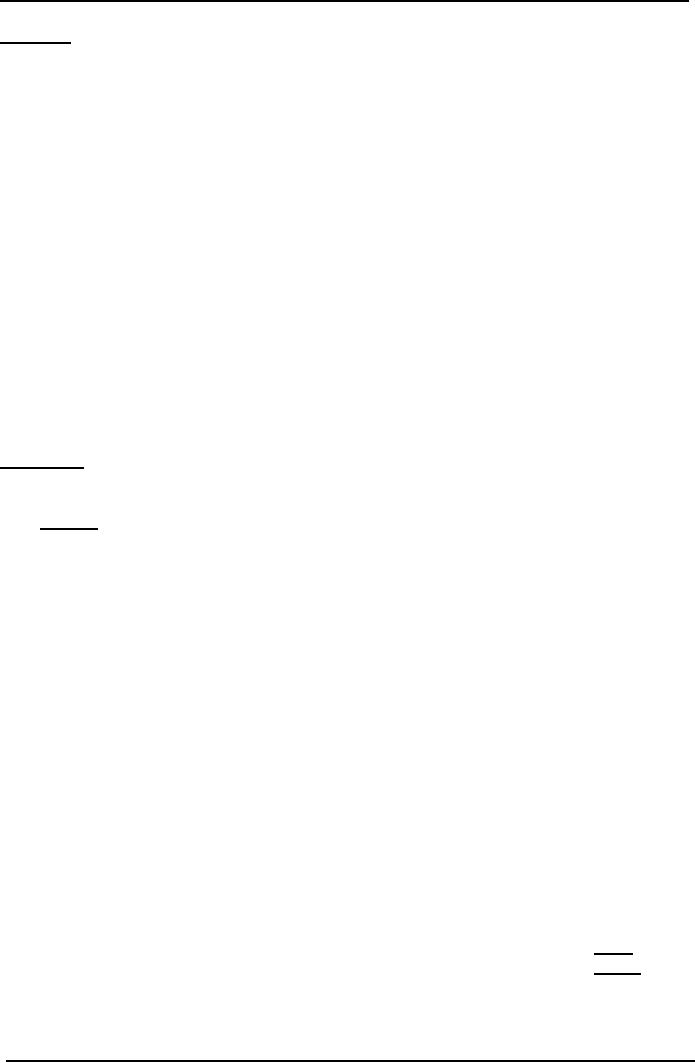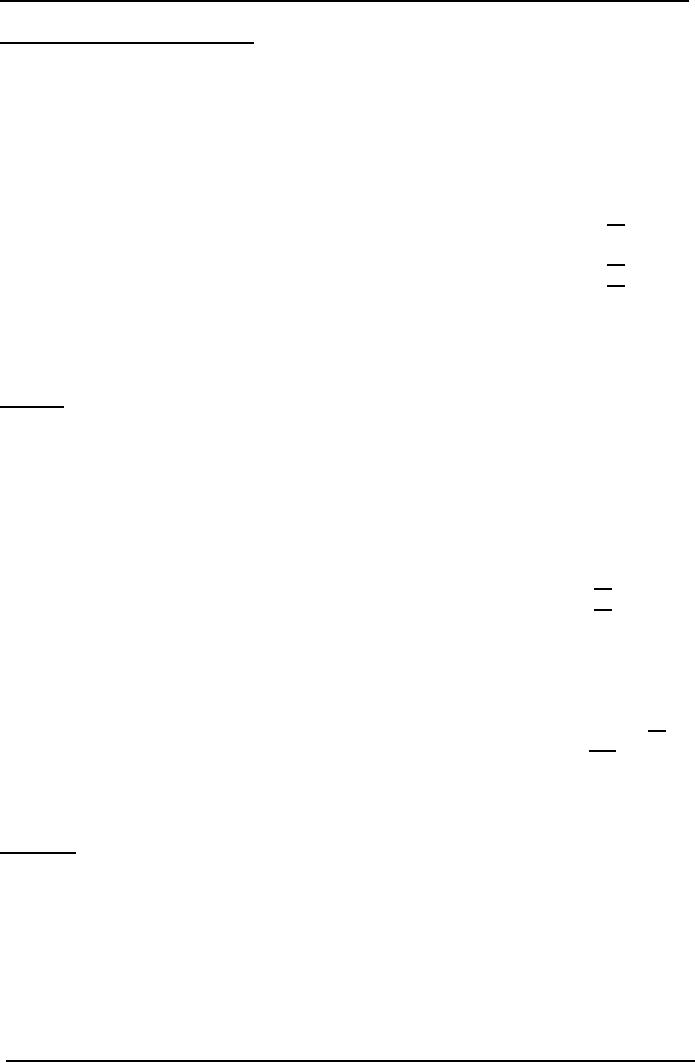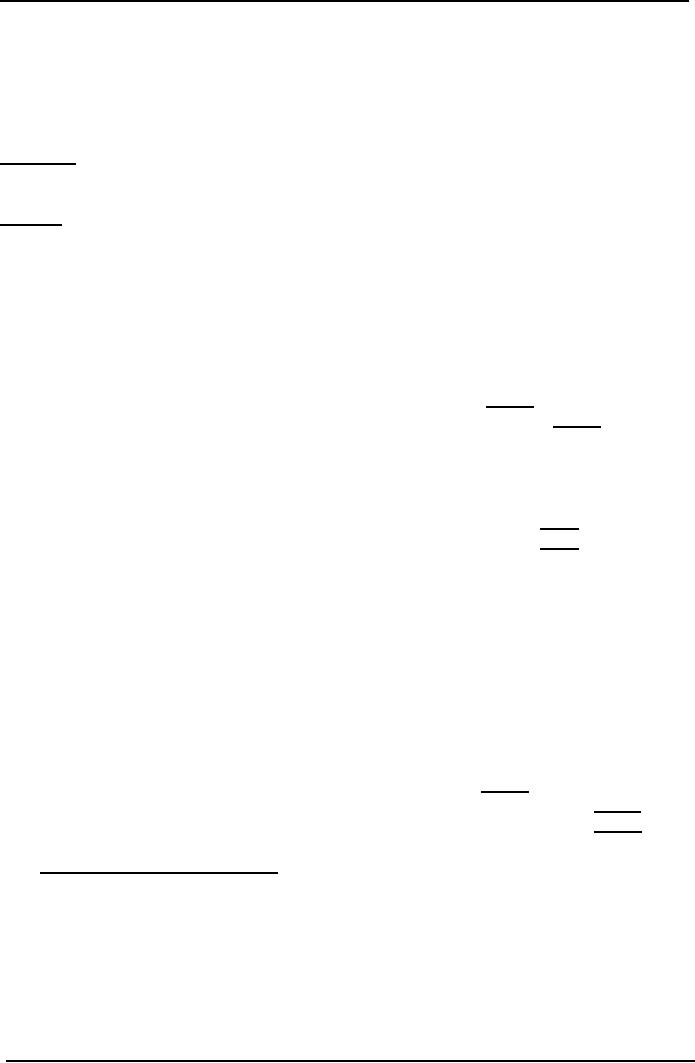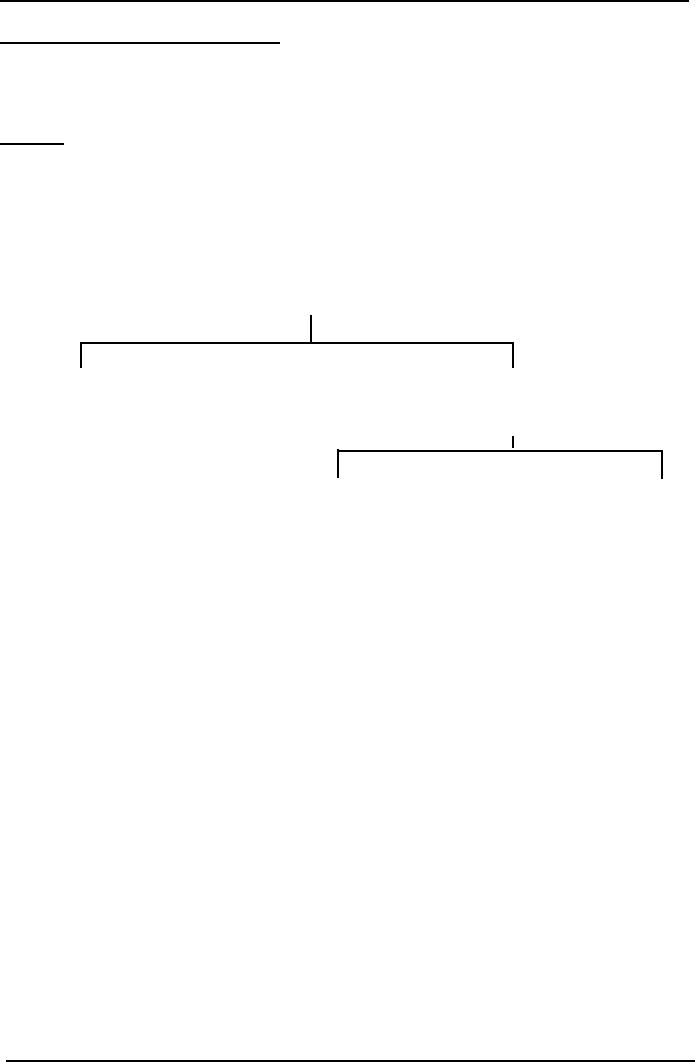 |
DECISION MAKING:Avoidable Costs, Non-Relevant Variable Costs, Absorbed Overhead |
| << DECISION MAKING:Size of fund, Income statement |
| DECISION MAKING CHOICE OF PRODUCT (PRODUCT MIX) DECISIONS >> |

Cost
& Management Accounting
(MGT-402)
VU
LESSON
# 43
DECISION
MAKING
Relevant
Costs
Relevant
costs are future cash
flows arising as a direct consequence of
a decision.
�
Relevant
costs are future
costs
�
Relevant
costs are cash
flows
�
Relevant
costs are incremental
costs
Decision
making should be based on relevant
costs.
a.
Relevant Costs are future
costs. A decision is about
the future and it cannot
alter what has
been
done already. Costs that
have been incurred in the
past are totally irrelevant
to any
decision
that is being made `now'.
Such costs are past
costs or sunk costs. Costs
that have
been
incurred include not only
costs that have already
been paid, but also
costs that have
been
committed. A committed cost is a
future cash flow that
will be incurred
anyway,
regardless
of the decision taken
now.
b.
Relevant costs are cash
flows. Only cash flow
information is required. This means
that
costs
or charges which do not
reflect additional cash spending (such as
deprecation and
national
costs) should be ignored for
the purpose of decision making.
c.
Relevant costs are incremental
costs. For example, if an
employee is expected to have
no
other
work to do during the next
week, but will be paid his
basic wage (of, say,
Rs. 100 per
week)(
for attending work and
doing nothing, his manager
might decide to give him a
job
which
earns the organization Rs.
40. The net gain is
Rs. 40 and the Rs.
100 is irrelevant to
the
decision because although it is a
future cash flow, it will be
incurred anyway whether
the
employee is given work or
not.
Avoidable
Costs
One
of the situations in which it is
necessary to identify the
avoidable costs is in
deciding
whether
or not to discontinue a product.
The only costs which
would be saved are
the
avoidable
costs which are usually
the variable costs and
sometimes some specific
costs. Costs
which
would be incurred whether or
not he product is discontinued
are known as
unavoidable
costs.
Differential
Costs and Opportunity
Costs
Relevant
costs are also differential
costs and opportunity
costs.
�
Differential
cost is the difference in
total cost between
alternatives.
�
An
opportunity cost is the value of
the benefit sacrificed when
one course of action
is
chosen in preference to an
alternative.
For
example, if decision option A
costs Rs. 300 and
decision option B costs Rs.
360, the
differential
costs is Rs. 60.
Example:
Differential Costs and
Opportunity Costs
Suppose
for example that there
are three options, A, B and
C, only one of which can
be
chosen.
The net profit from
each would be Rs. 80,
Rs. 100 and Rs. 70
respectively.
Since
only one option can be
selected option B would be
chosen because it offers the
biggest
benefit.
234

Cost
& Management Accounting
(MGT-402)
VU
Rs.
Profit
from option B
100
Less
opportunity cost (i.e. the
benefit from the most
profitable alternative, A)
80
Differential
benefit of option B
20
The
decision to choose option B
would not be taken simply
because it offers a profit of
Rs.
100,
but because it offers a
differential profit of Rs. 20 in
excess of the next best
alternative.
Controllable
and Uncontrollable
Costs
We
came across the term
controllable costs at the beginning of
this study text.
Controllable
costs
are items of expenditure
which can be directly
influenced by a given manger within
a
given
time span.
As
a general rule, committed
fixed costs such as those costs
arising form the possession
of
plant,
equipment and buildings
(giving rise to deprecation
and rent) are largely
uncontrollable
in
the short term because
they have been committed by
longer-term decisions.
Discretionary
fixed costs, for example,
advertising and research and
development costs can
be
thought of as being controllable
because they are incurred as
a result of decision made
by
management
and can be raised or lowered at
fairly short notice.
Sunk
Costs
A
sunk cost is a past cost
which is not directly
relevant in decision making. The
principle
underlying
decision accounting is the
management decisions can
only affect the future.
In
decision
making, managers therefore required
information about future
cots and revenues
which
would be affected by the decision
under review. They must
not be misled by
events,
costs
and revenues in the past,
about which they can do
nothing.
Sunk
costs, which have been
charged already as a cost of
sales in a previous
accounting
period
or will be charged in a future
accounting period although the
expenditure had
already
been
incurred, are irrelevant to
decision making.
Example:
Sunk Costs
An
example of a sunk cost is
development costs which have
already been incurred.
Suppose
that
a company has spent Rs.
250,000 in developing a new service
for customers, but
the
marketing
department's most recent findings are
that the service might
not gain customer
acceptance
and could be a commercial failure.
The decision whether or not
to abandon the
development
of the new service would
have to be taken, but the
Rs. 250,000 spent so
far
should
be ignored by the decision makers
because it is a sunk
cost.
Fixed
and Variable
Costs
Unless
you are given an indication to
the contrary, you should
assume the following:
�
Variable
costs will be relevant
costs.
�
Fixed
costs are irrelevant to a
decision.
This
need not be the case,
however, and you should
analyze variable and fixed
cost data
carefully.
Do not forget that `fixed'
costs may only be fixed in
the short term.
Non-Relevant
Variable Costs
There
might be occasions when a
variable cost is in fact a
sunk cost (and therefore a
non-
relevant
variable cost). For example,
suppose that a company has
some units of raw
material
235

Cost
& Management Accounting
(MGT-402)
VU
in
stock. They have been paid
for already, and originally
cost Rs. 2,000. They
are now
obsolete
and are no longer used in
regular production, and they
have no scrap value.
However,
they could be used in a
special job which the
company is trying to decide
whether
to
undertake. The special job is a
`non-off' customer order, and
would use up all
these
materials
in stock.
a.
In deciding whether the job
should be undertaken, the
relevant cost of the
materials
to
the special job is nil.
Their original cost of Rs.
2,000 is a sunk cost, and
should be
ignored
in the decision.
b.
However, if the materials did
have scrap value of, say,
Rs. 300, then their
relevant
cost
to the job would be the
opportunity cost of being unable to
sell them for
scrap,
i.e.
Rs. 300.
Attributable
Fixed Costs
There
might be occasions when a
fixed cost is a relevant
cost, and you must be
aware of the
distinction
`specific' or `directly attributable'
fixed costs, and general
fixed overheads.
Directly
attributable fixed costs are
those costs which, although
fixed within a relevant
range
of
activity level are relevant
to a decision for either of
the following
reasons.
a.
They could increase if certain extra
activities were undertaken. For
example, it may be
necessary
to employ an extra supervisor if a particular
order is accepted. The extra
salary
would
be an attributable fixed
cost.
b.
They would decrease or be eliminated
entirely if a decision were taken
either to reduce
the
scale of operations or shut down
entirely.
General
fixed overheads are those
fixed overheads which will
be unaffected by decisions to
increase
or decreased the scale of operations,
perhaps because they are an
apportioned share
of
the fixed costs of items
which would be completely
unaffected by the decision.
General
fixed
overheads are not relevant
in decision making.
Absorbed
Overhead
Absorbed
overhead is a national accounting
cost and hence should be
ignored for decision
making
purposes. It is overhead incurred
which may be relevant to a
decision.
The
Relevant Cost of Materials
The
relevant cost of raw
materials is generally their current
replacement cost, unless
the
materials
have already been purchased
and would not be replaced
once used. In this case
the
relevant
cost of using them is the
higher of the
following:
�
Their
current resale value
�
The
value they would obtain if
they were put to an alternative
use.
If
the materials have no resale
value and no other possible
use, then the relevant
cost of
using
them for the opportunity
under consideration would be
nil.
236

Cost
& Management Accounting
(MGT-402)
VU
Question
Majeed
Ltd. has been approached by
customer who would like a special
job to be done for
him,
and
who is willing to pay Rs.
22,000 for it. The
job would require the
following materials:
Total
units Units
Book
value
Realizable
Replacement
Material
required
already
in
of units in
value
cost
stock
stock
Rs./unit
Rs./unit
Rs./unit
A
1,000
0
-
-
6
B
1,000
600
2
2.50
5
C
1,000
700
3
2.50
4
D
200
200
4
6.00
9
Material
B is used regularly by Majeed
Ltd, and if units of B are
required for this job, they
would
need
to be replaced to meet other
production demand.
Materials
C and D are in stock as the
result of previous over-buying,
and they have a restricted
use.
No
other use could be found
for material C, but the
units of material D could be used in
another
job
as substitute for 300 units
of material E, which currently costs
Rs. 5 per unit (of
which the
company
has no units in stock at the
moment).
Required:
Calculate
the relevant costs of material
for deciding whether or not
to accept the
contract.
Answer
a.
Material A is not yet owned. It
would have to be bought in
full at the replacement cost
of
Rs.
6 per unit.
b.
Material B is used regularly by the
company. There are existing
stocks (600 units) but
if
these
are used on the contract
under review a further 600
units would be bought
to
replace
them. Relevant costs are
therefore 1,000 units at the
replacement cost of Rs.
5
per
unit.
c.
1,000 units of material C are
needed and 700 are
already in stock. If used for
the contract,
a
further 300 units must be
bought at Rs. 4 each. The
existing stocks of 700 will
not be
replaced.
If they are used for
the contract, they could
not be sold at Rs. 2.50
each. The
realizable
value of these 700 units is an
opportunity cost of sales revenue
forgone.
d.
The required units of material D are
already in stock and will
not be replaced. There is
an
opportunity
cost of using D in the contract
because there are alternative
opportunities
either
to sell the existing stocks
for Rs. 6 per unit
(Rs. 1,200 in total) or avoid
other
purchases
(of material E), which would
cost 300 x Rs. 5 = Rs.
1,500. Since
substitution
for
E is more beneficial, Rs. 1,500 is
the opportunity cost.
e.
Summary of relevant costs:
Rs.
Material
A (1,000 x Rs. 6)
6,000
Material
B (1,000 x Rs. 5)
5,000
Material
C (300 x Rs. 4) plus (700 x
Rs. 2.50)
2,950
Material
D
1,500
Total
15,450
The
Relevant Cost of Labor
The
relevant cost of labor, in
different situation, is best
explained by an example:
237

Cost
& Management Accounting
(MGT-402)
VU
Example:
Relevant Cost of Labor
LW
plc is currently deciding
whether to undertake a new contract. 15
hours of labor will
be
required
for the contract. LW plc
currently products product L,
the standard cost details of
which
are
shown below.
STANDARD
COST CARD
PRODUCT
L
Rs./Unit
Direct
Materials (10kg @ Rs. 2)
20
Direct
Labor (5 hrs @ Rs. 6)
30
50
Selling
price
72
Contribution
22
c.
What
is the relevant cost of
labor if the labor must be
hired form outside
the
organization?
d.
What
is the relevant cost of
labor if LW plc expects to
have 5 hours spare
capacity?
e.
What
is the relevant cost of
labor if labor is in short
supply?
Solution
a.
Where
labor must be hired from
outside the organization, the
relevant cost of labor
will
be
the variable costs
incurred.
Relevant
cost of labor on new
contract = 15 hours @ Rs. 6 =
Rs. 90.
b.
It
is assumed that the 5 hours
spare capacity will be paid
anyway, and so if these 5
hours
are
used on another contract,
there is no additional cost to LW
plc.
Rs.
Direct
labor (10 hours @ Rs.
6)
60
Spare
capacity (5 hours @ Rs.
0)
0
60
c.
Contribution
earned per unit of Product L
produced = Rs. 22
If
it requires 5 hours of labor to
make one unit of product L,
the contribution earned per
labor
hour
= Rs. 22/5 = Rs.
4.40.
Rs.
Direct
labor (15 hours @ Rs.
6)
90
Contribution
lost by not making product L
(Rs. 4.40 x 15 hours)
66
156
It
is important that you should
be able to identify the
relevant cost which are
appropriate to a
decision.
In many cases, this is a
fairly straightforward problem,
but there are cases where
great
care
should be taken. Attempt the
following question:
Question:
A
company has been making a machine to
order for a customer, but
the customer has since
gone
into
liquidation, and there is no prospect
that nay money will be obtained
from the winding up
of
the
company. Costs incurred to
date in manufacturing the machine
are Rs. 50,000 and
progress
payments
of Rs. 15,000 had been
received from the customer
prior to the
liquidation.
The
sales department has found
another company willing to
buy the machine for Rs.
34,000 once
it
has been completed.
To
complete the work, the
following costs would be
incurred.
a.
Materials:
These have been bought at a
cost of Rs. 6,000. They
have no other use, and
if
the
machine is not finished, they
would be sold for scrape for
Rs. 2,000.
238

Cost
& Management Accounting
(MGT-402)
VU
b.
Further
labor costs would be Rs.
8,000. Labor is in short
supply, and if the machine
is
not
finished, the work force
would be switched to another job,
which would earn Rs.
30,000 in
revenue,
and incur direct costs of
Rs. 12,000 and absorbed
(fixed) overhead of Rs.
8,000.
c.
Consultancy
fees Rs. 4,000. If the
work is not completed, the
consultant's contract
would
be
cancelled at a cost at Rs.
1,500.
d.
General
overheads of Rs. 8,000 would
be added to the cost of the
additional work.
Required:
Assess
whether the new customer's
offer should be
accepted.
Answer:
a.
Costs
incurred in the past, or revenue
received in the past are
not relevant because
they
cannot
affect a decision about what
is best for the future.
Costs incurred to date of
Rs. 50,000 and
revenue
received of Rs. 15,000 are
`water under the bridge' and
should be ignored.
b.
Similarly,
the price paid in the
past for the materials is
irrelevant. The only
relevant cost
of
materials affecting the
decision is the opportunity
cost of the revenue from
scrap which would
be
forgone Rs.
2,000.
c.
Labor
costs Rs Labor costs required to complete
work 8,000 opportunity
costs:
Contribution
forgone by losing other work
Rs. (30,000
12,000)
18,000
Relevant
cot of labor
26,000
d.
The
incremental cost of consultancy
from completing the work is
Rs. 2,500.
Rs.
Cost
of completing work
4,000
Cost
of canceling contract
1,500
Incremental
cost of completing
work
2,500
e.
Absorbed
overhead is a national accounting
cost and should be ignored.
Actual overhead
incurred
is the only overhead cost to
consider. General overhead costs (and the
absorbed overhead
of
the alternative work for
the labor force) should be
ignored.
f.
Relevant
costs may be summarized as
follows:
Rs.
Rs.
Revenue
from completing work
34,000
Relevant
Costs:
Materials:
Opportunity
cost
2,000
Labor:
Basic
pay
8,000
Opportunity
Cost
18,000
Incremental
cost of consultant
2,500
30,500
Extra
profit to be earned by accepting
the order
3,500
The
Deprival Value of an
Asset
The
deprival value of an asset represents the
amount of money that a
company would have to
receive
if it were deprived of an asset in order
to be no worse off than it
already is.
The
deprival value of an asset is best demonstrated by
means of an example.
239

Cost
& Management Accounting
(MGT-402)
VU
Example:
Deprival Value of an
Asset
A
machine cost Rs. 14,000 ten
years ago. It is expected
that the machine will
generate future
revenues
of Rs. 10,000. Alternatively,
the machine could be scrapped
for Rs. 8,000. An
equivalent
machine
in the same condition would
cost Rs. 9,000 to buy
now. What is the deprival value of
the
machine?
Solution
Firstly,
let us think about the
relevance of the costs given to us in
the question.
Cost
of machine = Rs. 14,000 = past/sunk
cost
Future
revenues = Rs. 10,000 = revenue
expected to be generated
Net
realizable value = Rs. 8,000 =
scrap proceeds
Replacement
cost = Rs. 9,000
When
calculating the deprival value of an
asset, use the following
diagram.
Lower
of
Replacement
Revenue
Cost
Expected
(Rs.
9,000)
(Rs.
10,000)
Higher
of
NRV
(Rs.
10,000)
(Rs.
8,000)
Therefore,
the deprival value of the machine is the
lower of the replacement
cost and Rs.
10,000.
The
deprival value is therefore Rs.
9,000.
240
Table of Contents:
- COST CLASSIFICATION AND COST BEHAVIOR INTRODUCTION:COST CLASSIFICATION,
- IMPORTANT TERMINOLOGIES:Cost Center, Profit Centre, Differential Cost or Incremental cost
- FINANCIAL STATEMENTS:Inventory, Direct Material Consumed, Total Factory Cost
- FINANCIAL STATEMENTS:Adjustment in the Entire Production, Adjustment in the Income Statement
- PROBLEMS IN PREPARATION OF FINANCIAL STATEMENTS:Gross Profit Margin Rate, Net Profit Ratio
- MORE ABOUT PREPARATION OF FINANCIAL STATEMENTS:Conversion Cost
- MATERIAL:Inventory, Perpetual Inventory System, Weighted Average Method (W.Avg)
- CONTROL OVER MATERIAL:Order Level, Maximum Stock Level, Danger Level
- ECONOMIC ORDERING QUANTITY:EOQ Graph, PROBLEMS
- ACCOUNTING FOR LOSSES:Spoiled output, Accounting treatment, Inventory Turnover Ratio
- LABOR:Direct Labor Cost, Mechanical Methods, MAKING PAYMENTS TO EMPLOYEES
- PAYROLL AND INCENTIVES:Systems of Wages, Premium Plans
- PIECE RATE BASE PREMIUM PLANS:Suitability of Piece Rate System, GROUP BONUS SYSTEMS
- LABOR TURNOVER AND LABOR EFFICIENCY RATIOS & FACTORY OVERHEAD COST
- ALLOCATION AND APPORTIONMENT OF FOH COST
- FACTORY OVERHEAD COST:Marketing, Research and development
- FACTORY OVERHEAD COST:Spending Variance, Capacity/Volume Variance
- JOB ORDER COSTING SYSTEM:Direct Materials, Direct Labor, Factory Overhead
- PROCESS COSTING SYSTEM:Data Collection, Cost of Completed Output
- PROCESS COSTING SYSTEM:Cost of Production Report, Quantity Schedule
- PROCESS COSTING SYSTEM:Normal Loss at the End of Process
- PROCESS COSTING SYSTEM:PRACTICE QUESTION
- PROCESS COSTING SYSTEM:Partially-processed units, Equivalent units
- PROCESS COSTING SYSTEM:Weighted average method, Cost of Production Report
- COSTING/VALUATION OF JOINT AND BY PRODUCTS:Accounting for joint products
- COSTING/VALUATION OF JOINT AND BY PRODUCTS:Problems of common costs
- MARGINAL AND ABSORPTION COSTING:Contribution Margin, Marginal cost per unit
- MARGINAL AND ABSORPTION COSTING:Contribution and profit
- COST – VOLUME – PROFIT ANALYSIS:Contribution Margin Approach & CVP Analysis
- COST – VOLUME – PROFIT ANALYSIS:Target Contribution Margin
- BREAK EVEN ANALYSIS – MARGIN OF SAFETY:Margin of Safety (MOS), Using Budget profit
- BREAKEVEN ANALYSIS – CHARTS AND GRAPHS:Usefulness of charts
- WHAT IS A BUDGET?:Budgetary control, Making a Forecast, Preparing budgets
- Production & Sales Budget:Rolling budget, Sales budget
- Production & Sales Budget:Illustration 1, Production budget
- FLEXIBLE BUDGET:Capacity and volume, Theoretical Capacity
- FLEXIBLE BUDGET:ANALYSIS OF COST BEHAVIOR, Fixed Expenses
- TYPES OF BUDGET:Format of Cash Budget,
- Complex Cash Budget & Flexible Budget:Comparing actual with original budget
- FLEXIBLE & ZERO BASE BUDGETING:Efficiency Ratio, Performance budgeting
- DECISION MAKING IN MANAGEMENT ACCOUNTING:Spare capacity costs, Sunk cost
- DECISION MAKING:Size of fund, Income statement
- DECISION MAKING:Avoidable Costs, Non-Relevant Variable Costs, Absorbed Overhead
- DECISION MAKING CHOICE OF PRODUCT (PRODUCT MIX) DECISIONS
- DECISION MAKING CHOICE OF PRODUCT (PRODUCT MIX) DECISIONS:MAKE OR BUY DECISIONS